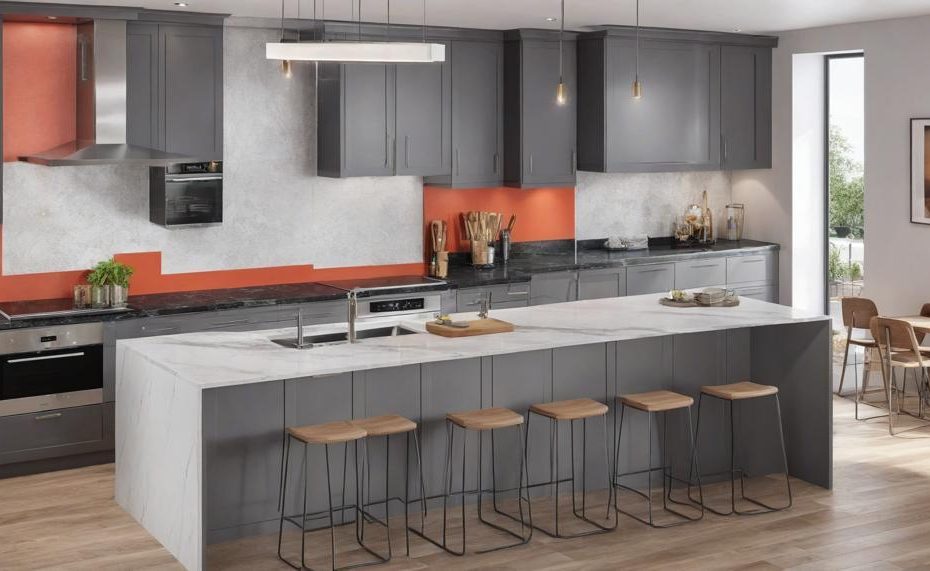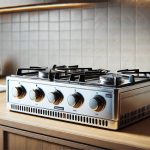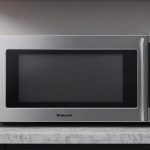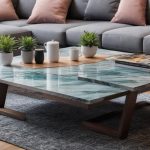Achieving a smooth, flawless finish on your kitchen cabinets can elevate the look of your entire kitchen. Whether you’re refreshing your space or completely remodeling, a silky-smooth paint job on the cabinets is key to a professional look.
To achieve that pristine finish, here are some essential tips and tricks:
- Choose the Right Paint: Opt for non-yellowing, self-leveling paints that reduce visible brush strokes and provide a lasting finish.
- Prepare Thoroughly: Proper preparation is crucial. Clean, sand, and prime the cabinets to create an ideal surface for painting.
- Fill the Grain: For wooden cabinets with a pronounced grain, filling the grain before painting ensures a smooth surface.
- Use Quality Tools: High-quality brushes, rollers, or paint sprayers can make a significant difference. Each tool has its benefits; for example, a sprayer can minimize marks, while a good brush can still achieve a smooth finish.
- Sanding Between Coats: Sanding with 300-400 grit sandpaper between coats helps in achieving a velvety smooth finish.
- Condition the Paint: Stir the paint thoroughly and consider adding Floetrol to enhance smoothness and reduce brush marks.
- Apply Multiple Coats: Especially with bright white paints, multiple coats may be necessary to achieve full coverage and a smooth finish.
- Avoid Waxing: Skip the wax as it needs frequent reapplication and does not offer durable protection.
Following these tips will ensure your kitchen cabinets look professionally painted and enhance the overall aesthetic of your kitchen. Dive into the painting process with confidence, and enjoy the transformation of your kitchen space.
Contents
The Best Paints for Painting Cabinets
The best paints for achieving a smooth finish when painting kitchen cabinets are:
| Type of Paint | Description | Benefits |
| Acrylic-Based All-in-One Paint | Specifically designed for cabinets, this paint can withstand humidity and temperature fluctuations. | Resistant to humidity, durable finish, ideal for kitchen environments. |
| Satin Enamel Paint | Known for its super smooth finish and urethane-acrylic formula, providing both beauty and durability. | Super smooth finish, high durability, suitable for high-traffic areas. |
| Semi-Gloss Paint and Primer | This 100% acrylic base paint resists mildew and stains, making it perfect for kitchen cabinets. | Mildew resistant, stain-resistant, easy to clean. |
| Oil-Enriched Enamel Paint | Dries to a smooth, factory-like finish, resistant to fading, scratching, and scuffing. | Factory-like finish, highly durable, scratch and fade resistant. |
Achieving a smooth finish involves more than just selecting the right paint. Here are some key tips:
- Preparation: Properly clean, sand, and prime your cabinets.
- Application: Use a high-quality brush or roller, or a paint sprayer to avoid brush strokes and roller marks.
- Sanding: Lightly sand between coats with 300-400 grit sandpaper.
- Stirring: Stir the paint well, and consider using a paint conditioner like Floetrol to help with a smoother application.
- Multiple Coats: Apply multiple coats, especially with bright white paints, for the best coverage and finish.
Painting Oak Cabinets
To achieve a smooth finish on oak cabinets, follow these detailed steps:
| Step | Description | Details |
| Gather Supplies | Ensure you have all the necessary materials before starting. |
|
| Remove Hardware | Take off all cabinet doors, drawers, and hardware. |
|
| Clean Cabinets | Thoroughly clean to remove grease, dirt, and grime. |
|
| Sanding | Sand all surfaces to ensure the primer and paint adhere well. |
|
| Prime the Surface | Apply an oil-based primer to seal the wood grain and prevent bleed-through. |
|
| Sand After Priming | Lightly sand the primed surface for an ultra-smooth base. |
|
| Paint Application | Apply high-quality paint in thin, even coats. |
|
| Final Sanding and Touch-ups | Lightly sand between coats for the best finish. |
|
| Reassemble Cabinets | Reattach doors, drawers, and hardware once the paint has fully cured. |
|
Painting cabinets using a paint sprayer
Using a paint sprayer to paint kitchen cabinets offers several benefits, primarily centred around achieving a smooth and professional finish. Here’s a breakdown of why a paint sprayer is an excellent choice:
Benefits of Using a Paint Sprayer:
Smooth, Even Finish:
- Paint sprayers eliminate brush strokes and roller marks, ensuring a flawless surface.
- Ideal for achieving a factory-like finish that looks professionally done.
Efficiency and Speed:
- Sprayers cover large surfaces quickly, significantly reducing painting time.
- Excellent for intricate designs and hard-to-reach areas that brushes and rollers struggle with.
Consistency:
- Delivers a consistent layer of paint, avoiding thick and thin spots.
- Ensures uniform colour and texture across all cabinet surfaces.
Versatility:
- Suitable for various paint types, including latex, enamel, and chalk paint.
- Can be used on different cabinet materials, from wood to laminate.
Professional Results:
- Gives a high-quality, durable finish that is difficult to achieve with brushes and rollers.
- Suitable for both primer and paint, streamlining the painting process.
Achieving a Smooth Finish
Preparation:
- Proper prep work is crucial. Clean, sand, and prime the cabinets thoroughly to ensure the paint adheres well.
Technique
- Apply multiple thin coats rather than a few thick ones. This helps in achieving a smooth, even finish without drips.
- Use slow, steady strokes and maintain a consistent distance from the surface to avoid uneven application.
Equipment
- High-quality paint sprayers, such as HVLP (High Volume Low Pressure) systems, provide better control and reduce overspray.
- Consider using self-leveling paint to minimise visible brush strokes and ensure a smoother finish.
How to get a smooth finish on cabinets using a paint roller and paint brush
Achieving a smooth finish when painting kitchen cabinets requires a combination of high-quality tools, proper preparation, and meticulous technique. Here are the best techniques to follow:
Preparation
- Clean and Sand: Start by thoroughly cleaning the cabinets to remove grease and grime. Lightly sand the surfaces with 120-150 grit sandpaper to create a good surface for the primer to adhere.
- Fill the Grain: For wood cabinets with a pronounced grain, use a grain filler to smooth out the surface before painting.
Priming
- Apply a Quality Primer: Use a high-quality, bonding primer to ensure the paint adheres well and provides a smooth base. A foam roller works well for flat surfaces, while a brush is ideal for detailed areas.
Painting
- First Coat with a Roller: Apply the first coat of paint with a high-density foam roller to minimize texture. Roll in long, even strokes, and avoid overloading the roller with paint.
- Brush the Details: Use a high-quality, angled brush, such as a Purdy 2.5″ angled brush, to paint any raised trim or areas that the roller can’t reach. Brush in the direction of the grain or the previous roller strokes.
Sanding Between Coats
- Fine Grit Sandpaper: After the first coat dries, lightly sand the surface with 300-400 grit sandpaper. This step helps to smooth out any imperfections and prepares the surface for the next coat.
Subsequent Coats
- Repeat: Apply at least one or two more coats of paint, repeating the rolling and brushing process. Sand lightly between each coat for the smoothest finish.
Final Touch
- Light Brush Strokes: For the ultimate smooth finish, roll on the final coat and then lightly brush over it with a damp, high-quality brush. This technique helps to eliminate any remaining roller texture.
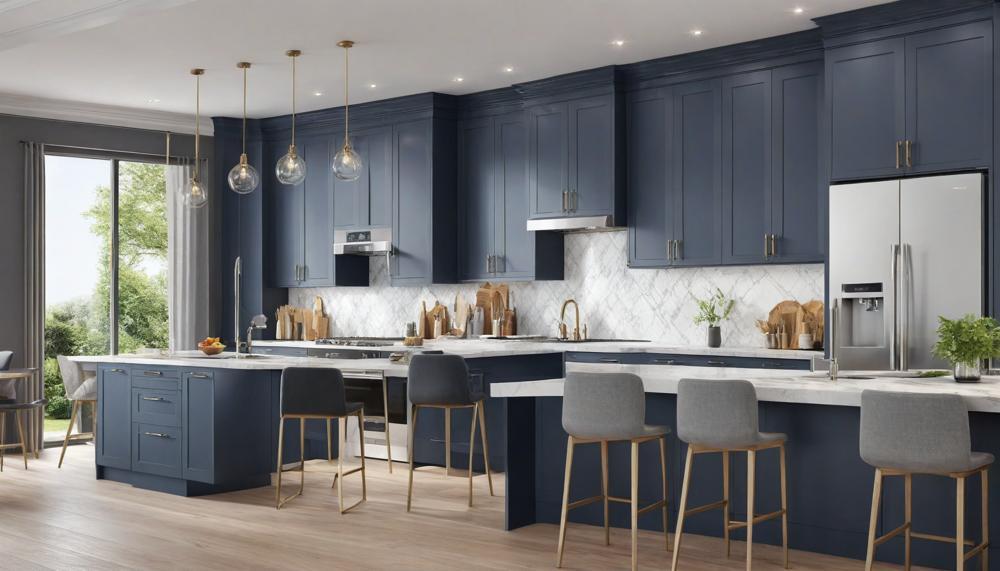
Tips and Tricks
- Use High-Quality Paint: Opt for non-yellowing, self-leveling paints specifically designed for cabinets.
- Additives: Consider adding a paint conditioner like Floetrol to help the paint flow better and reduce brush strokes.
- Multiple Thin Coats: Apply several thin coats rather than one thick coat to avoid drips and ensure a smooth finish.
- Proper Drying Time: Allow sufficient drying time between coats to avoid tackiness and ensure durability.
Recommended Tools
| Tool | Purpose | Recommendation |
| Angled Brush | Detailed areas and trim | Purdy 2.5″ Angled Brush |
| Foam Roller | Flat surfaces | High-Density Foam Roller |
| Sandpaper | Smoothing between coats | 300-400 Grit Sandpaper |
| Grain Filler | Prepping wood grain | Water-Based Grain Filler |
How to Get a Super Smooth Finish When Painting Cabinets – With or Without a Paint Sprayer
Achieving a smooth finish when painting kitchen cabinets is crucial for a professional and polished look. The best techniques for achieving this depend on whether you are using a paint sprayer or traditional tools such as a roller and brush.
Using a paint sprayer
Using a paint sprayer is the easiest way to achieve a super smooth finish on cabinets. However, it requires more prep work and can be more expensive. Here are the steps to follow for using a paint sprayer:
- Make sure to properly clean and sand the cabinets before painting.
- Use a high-quality non-yellowing and self-leveling paint for best results.
- Fill in any pronounced grain with wood filler before painting.
- Stir the paint well and add Floetrol if needed to help the paint flow smoothly through the sprayer.
- Apply multiple thin coats of paint, allowing each coat to dry completely before adding another.
- Clean the sprayer thoroughly after each use to prevent clogging.
Using a roller and brush
Although not as easy as using a sprayer, achieving a smooth finish with a roller and brush is possible with the right techniques. Here’s how:
- Use high-quality brushes such as Purdy or Americana Decor to prevent brush strokes.
- For raised trim areas, use a smaller brush for better control.
- Load the roller lightly with paint to avoid drips and apply in long even strokes.
- Use a foam roller for the first coat to help achieve a smoother finish.
- Sand between coats with 300-400 grit sandpaper to avoid brush strokes and roller marks.
- After the final coat, run a damp paint brush lightly over the surface for an extra smooth finish.
In conclusion, achieving a smooth finish when painting kitchen cabinets requires proper preparation, quality products, and patience. Whether using a sprayer or traditional tools, following these techniques will help you achieve stunning results.
Conclusion
Achieving a flawless, smooth finish on kitchen cabinets can truly transform the look and feel of your kitchen. To ensure a professional-quality result, follow these key steps. Start by selecting the right paint—opt for non-yellowing, self-leveling options that minimize brush strokes and ensure durability. Thorough preparation is essential: clean, sand, and prime your cabinets to create a perfect painting surface.
For wooden cabinets with a noticeable grain, using a grain filler will help achieve that silky finish. High-quality tools make a significant difference as well. Whether you choose a high-end brush, a roller, or a paint sprayer, each can contribute to a smooth application, with sprayers often being the best for eliminating brush marks.
Between coats, lightly sand with 300-400 grit sandpaper to maintain a velvety texture. Condition your paint by stirring it thoroughly and adding a conditioner like Floetrol to reduce brush marks. Applying multiple coats is often necessary, especially with lighter colors, to achieve full coverage and a pristine look. Finally, avoid using wax as it requires frequent reapplication and doesn’t provide long-term protection.
